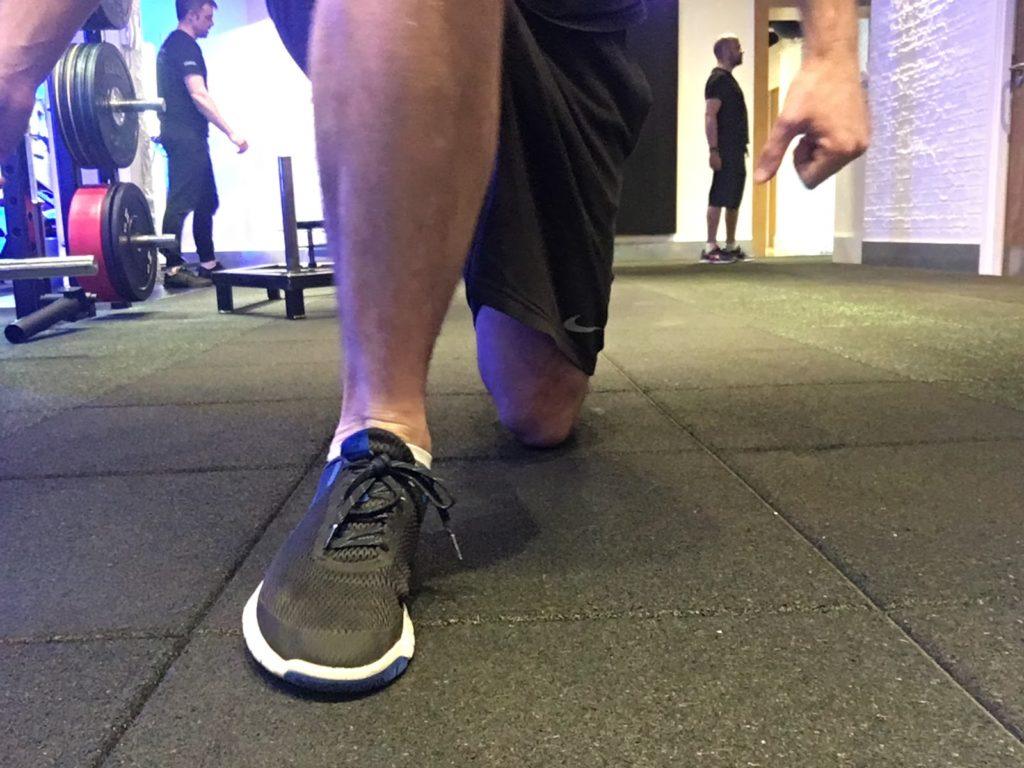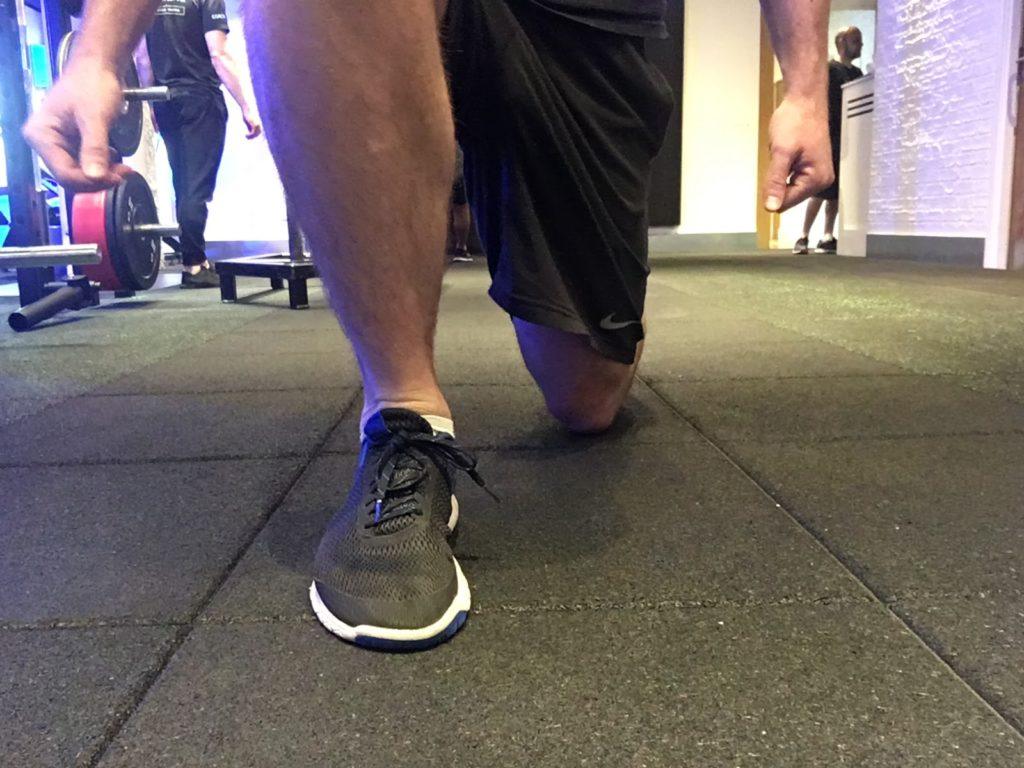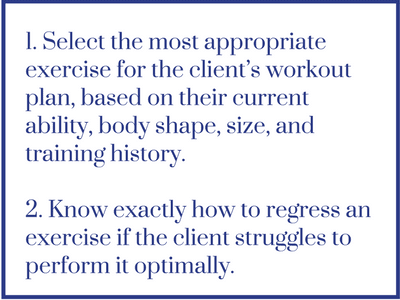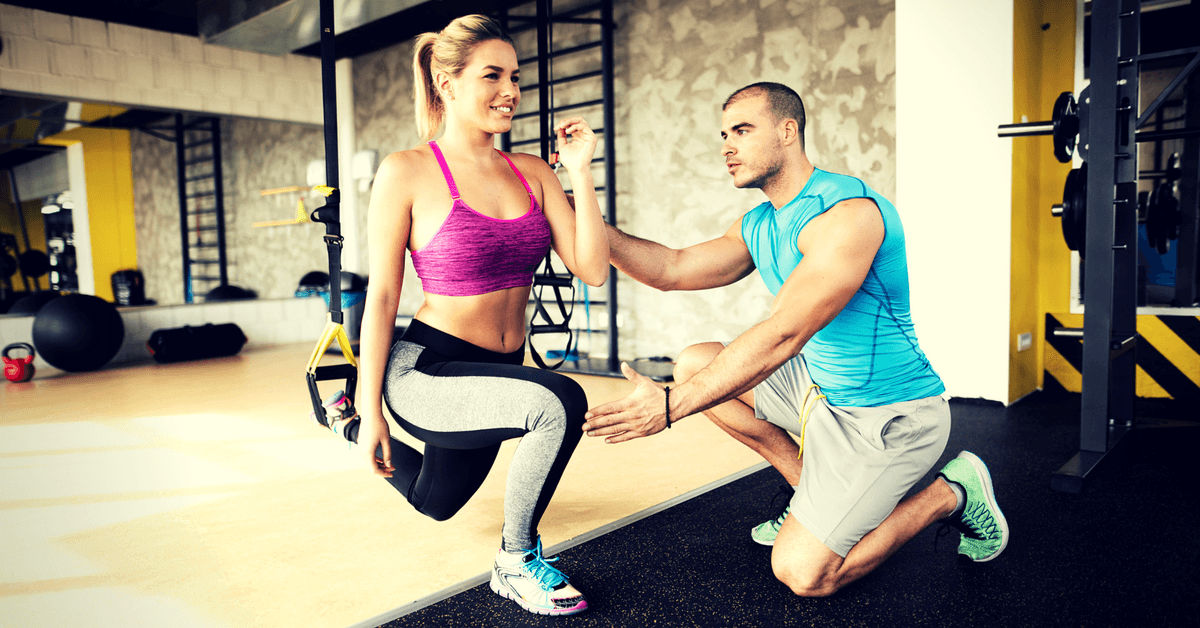One of the unspoken golden rules of personal training is, we must make sure the client fits the demands of the exercise and avoid trying to force the exercise onto the client.
If a client struggles with a particular exercise, you should either regress it to something less complex or choose a more suitable exercise variation. Most fitness coaches already know that poor technique can either rob the client of strength development, or worse, lead to a nasty injury.
So why is it that so many personal trainers try to foist certain exercises upon the client, particularly beginners?
Below I’ve listed five exercises that trainers seem to love to program, no matter what. To be clear, each exercise is great in its own right, but I’ll explain why they may not be a suitable choice for beginner clients, how to regress them, and which exercise(s) personal trainers could do instead.
1. Trap bar deadlift
In a trap bar deadlift, the client stands “inside” the weight, making the forces acting on the spine compressive and reducing the load on the lower back. Additionally, the higher handles of the trap bar allow the client to more easily set up in the starting position. Both of these may make the trap bar deadlift appealing as a deadlift option for beginner clients.
Although the trap bar deadlift is a perfectly viable option for clients who may be suffering from low back pain or lack the hip mobility to assume proper starting position from the floor, you need to consider a few other prerequisites prior to introducing the exercise into a workout routine.
The most important movement pattern for the deadlift is the hip hinge, which demonstrates the ability to fix the lumbar spine in place and move solely at the hips.
In the video above, you can see that nearly all the movement happens at the hips, with minimal movement at the knee.
But when setting up for the deadlift, beginner clients might need to bend their knees more in order to get lower to the bar, which will eccentrically load the knee-extensor muscles (the quadriceps) while also taking tension away from the hamstrings and glutes.
With more tension on the quads, combined with minimal experience with actively recruiting the hips to perform hip-dominant movements, these clients end up turning the exercise into a knee-dominant exercise--a big mistake and something you should fix. Here’s a video that shows the difference between a knee-dominant trap bar deadlift and a hip-dominant trap bar deadlift:
The above is the incorrect technique. Notice how the movement is initiated with hip extension (i.e. the knees shoot backwards) and looks very lazy and incomplete. The video below shows the correct technique:
Notice the distinct hip extension that concludes the lift. The difference is subtle, but it should still be corrected. Otherwise, your client may have limited deadlift strength, decreased ability to build glute muscles, or hurt their lower back with heavier weights.
What to do instead:
If you notice that your client is using their knee extensors as the prime movers during the trap bar deadlift, then regress to a stricter hip hinge, which involves minimal knee movement and encourages stricter use of the hips. Examples include:
Kneeling hip hinge
Standing hip hinge
Romanian deadlift
Cable pull-through
All of the above exercises are initiated by an eccentric action and teach the client to “feel” their hips during standing hip extension movements.
Once they can demonstrate the ability to perform standing hip extension, driven by the glutes, then they are ready to return to the trap bar deadlift.
2. Kettlebell swing
Some coaches may be in love with the kettlebell swing and program it as the first hip-dominant movement pattern that their clients should perform. This is a mistake.
The kettlebell swing is initiated by an eccentric phase, which makes it easier to perform in theory. But the speed at which the exercise should be performed is beyond the ability of some clients to rapidly transition from an eccentric to a concentric contraction.
As a result, they may engage the quads to assist with the upward swing phase of the movement--thus letting the hips slack off--and rely on their lower back, which puts a lot of undue stress on their lumbar spine. Watch these videos below to get a clearer idea:
Knee-dominant kettlebell swing
Much like the knee-dominant trap bar deadlift, the swing is initiated by the knees extending, which decreases the involvement of the hips.
Back-dominant kettlebell swing
Here the swing is completed by hyperextending the lower back. Notice also how the hips fail to reach full extension.
Hip-dominant kettlebell swing (Correct way)
In the above (correct) video, the swing is initiated and then dominated by the hips, which powerfully move from a flexed to an extended position.
What to do instead:
Before programming the kettlebell swing, you must first make sure that your client is fully capable of engaging the posterior chain during loaded hip hinge patterns at slow speeds. Examples include standing hip hinge, pull-throughs, and Romanian deadlifts--all of which were also examples in previous points.
Throughout these movements, there are four things to closely look out for:
- Simultaneous movement of the hips and knees: Neither should move by themselves.
- Contraction of the glutes: Don’t be afraid of staring at your client’s butt. You’re watching for the muscle to change shape. If it looks very relaxed through the movement, then it’s fair to assume the glutes are not thoroughly being engaged.
- Hips dominating the movement: This may take time to be able to observe, but you’re looking for hip extension to drive the knee extension and not the other way around.
- Minimal movement in the lower back: The lower back should be still during the entire movement, with zero hyperextension in the end position.
As your client’s strength and confidence increase, only then should these movements be performed more explosively or with the addition of a kettlebell.
3. Dumbbell bench press
The dumbbell bench press can often be misrepresented as a regression of the barbell bench press.
In reality, using dumbbells instead of a barbell is a variation of the bench press, not a regression. Plus, dumbbells don’t actually make the exercise any easier to perform.
If the client is new to training and has poor stability in their shoulders, they may struggle to stabilize the weight at the start. You don’t need a degree in exercise science to know that holding heavy weight unsteadily over your face is nothing but a terrible idea!
What’s more, any instability at the joint will increase neural inhibition of to the prime movers (the pectorals, triceps, and deltoids), meaning that the client will have to use very light weights to perform the exercise through a safe range of motion. And if the client’s goal is to improve strength and/or body composition, then light weights won’t benefit their goal.
What to do instead:
If you need to regress the bench press, then use the push-up exercise (use an elevated surface, like placing hands on a chair, if need be).
The push-up is a closed chain exercise, which means that their hands are fixed on an immobile surface, such as the floor, and do not move during the movement. This increases the recruitment of the shoulder stabilisers.
What’s more, the added stability increases the stimuli to the working muscles (chest, shoulders and triceps). And you don’t have to fear weight being dropped on the client’s face.
When the client is comfortably performing push-ups on the ground, then you can be sure that they will have the shoulder stability, as well as the strength, to perform the dumbbell bench press safely.
4. Walking lunges
Walking lunges are very effective in fat loss programs. The instability they produce, the time it takes to complete a single set, and the exercise’s awkward nature all can really help jack up a client’s heart rate.
Although it looks like your client only needs to put one leg in front of the other and bend forward, proper execution involves the client being able to stabilize as soon as their foot hits the ground.
Here a common problem is the lead foot’s tendency toward pronation. This can reduce hip involvement during the concentric action and potentially lead to additional stress being placed upon the knee joint.

Foot pronated in lunge position

Correct foot position during the lunge
What to do instead:
We’ll assume that cueing here doesn’t effectively help keep the foot flat. If the client cannot keep their foot flat and stabilize, then we must simply accept that walking lunges exceed that client’s current capabilities.
In this case, regress the exercise either in the fitness program to a reverse lunge or a split-squat variation. The goal with these is to keep the client’s front foot still during the movement and teach proper stability during the eccentric action.
5. Push press
When it comes to overhead movements, the push press is a seemingly straightforward exercise to do.
In a push press, the lifter uses momentum from the lower body to get the weight off the shoulders and into a more mechanically advantageous position from which to press. Because the shoulders and triceps don’t have to work during the first part of the push press, more weight can be handled.
For beginner clients, however, it’s not a good idea to put more weight over their head than they can safely handle. Joint instability issues, for example, may not become apparent until the weight is in the last place you want it: above the client’s head.
What to do instead:
If we want to program overhead pressing into your fitness plan, our clients would be better off learning the strict overhead press prior to learning the push press.
As I’ve demonstrated in the previous examples, we should teach slower velocity movements before progressing to higher velocity exercises. Why? Well, let’s use a power clean as an example. We’d make sure that the client can perform a deadlift first, since the movement here comprises the first part of the power clean and ensures that the hips are properly used to lift the weight from the floor and into the correct position.
This rule shouldn’t be any different for overhead movements: slower speed movements should be mastered before progressing to exercises that are inherently faster in nature.
We want to build strength through the whole range of motion and only apply overload when a suitable foundation of strength has been built. Suitable overhead movements to use with a beginner include:
Barbell press
One-arm dumbbell press
Half-kneeling landmine press
Landmine press
Split stance landmine press
To summarize, the main two points of coaching are to:

Always be prepared to adapt your exercise choice based on what you see with the client. And remember that it’s always better to have a client completely dominate an easier exercise than really struggle (or worse, hurt themselves) with a more advanced variation.











